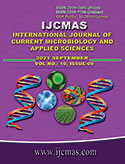


 National Academy of Agricultural Sciences (NAAS)
National Academy of Agricultural Sciences (NAAS)

|
PRINT ISSN : 2319-7692
Online ISSN : 2319-7706 Issues : 12 per year Publisher : Excellent Publishers Email : editorijcmas@gmail.com / submit@ijcmas.com Editor-in-chief: Dr.M.Prakash Index Copernicus ICV 2018: 95.39 NAAS RATING 2020: 5.38 |
Besides, the inherent hazards, negative public perceptions about the adverse environmental pollution of chemical pesticides, an alternative control methods are needed. Bio-stimulants are eco-friendly alternative to chemical pesticides because of their minimal impact on human health and environment, while ensuring optimal increase of crop yield, quality and tolerance to biotic stress. The soil has an enormous untapped potential of microbes, showing antagonistic effects against soil borne plant pathogenic organisms. This work validates a procedure to select one of the best Plant Growth Promoting Rhizobacteria (PGPR) as potential active ingredients for controlling Sheath blight of rice, incited by Rhioctonia solani (Kuhn). It is one of the most important Necrotrophic fungal diseases of rice with approximately 58% yield reduction in test plots of susceptible cultivars. It was arduous to manage the disease, therefore by investigating the bio-control potential of Pseudomonas fluorescens for the successful management of R. solani causing sheath blight disease. The results showed that the bacterial antagonist P. fluorescens has exhibited strong inhibition against R. solani with 76.40 Per cent over control in dual culture technique. With regard to poisoned food technique the culture filtrates of P. fluorescens (Pf3) at 15 and 20 per cent conc. completely inhibited the mycelial growth of R. solani. In addition to the disease control, the isolate Pf3 recorded the maximum root and shoot length; with germination percentage (96.18) and vigour index (2429.50) thereby it promotes plant growth and seed germination.
 |
 |
 |
 |
 |